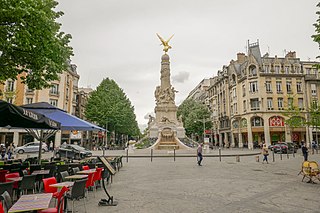
Reims is the most populous city in the French department of Marne, and the 12th most populous city in France. The city lies 129 km (80 mi) northeast of Paris on the Vesle river, a tributary of the Aisne.
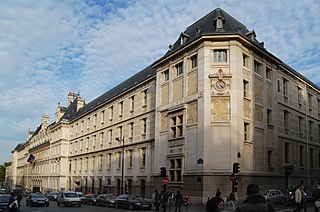
The Lycée Louis-le-Grand, also referred to simply as Louis-le-Grand or by its acronym LLG, is a public Lycée located on rue Saint-Jacques in central Paris.

The Abbey of St. Jean des Vignes was a monastery of Augustinian canons in Soissons, France, southwest of the city center. Only ruins remain, of which the west facade is one of the more outstanding examples of architecture in the town. It is a listed historic monument.

The Lycée Charlemagne is located in the Marais quarter of the 4th arrondissement of Paris, the capital city of France.

The Roman College was a school established by St. Ignatius of Loyola in 1551, just 11 years after he founded the Society of Jesus (Jesuits). It quickly grew to include classes from elementary school through university level and moved to several successive locations to accommodate its burgeoning student population. With the patronage of Pope Gregory XIII, the final seat of the Roman College was built in 1584 near the center of Rome's most historic Pigna district, on what today is called Piazza del Collegio Romano, adding the church of St. Ignatius in 1626, and a renowned observatory in 1787. The college remained at this location for 286 years until the revolutionary Capture of Rome in 1870.

Lebanon is among the oldest sites of wine production in the world. The Israelite prophet Hosea is said to have urged his followers to return to God so that "they will blossom as the vine and fame be like the wine of Lebanon, [and] their fragrance will be like that of Lebanon". The Phoenicians of the coastal strip were instrumental in spreading wine and viticulture throughout the Mediterranean in ancient times.
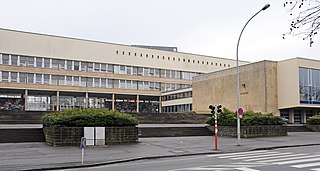
The Athénée de Luxembourg, is a high school situated in Luxembourg City, in southern Luxembourg. Throughout the school's history of more than 400 years, its name was changed repeatedly. It is popularly known in Luxembourgish as the Stater Kolléisch or (De) Kolléisch, and is the nation's oldest school still in existence.
Maison Louis Latour is a merchant and owner of red and white wines in Burgundy, France. It has remained independent and family-owned since 1797. Maison Louis Latour has the largest holding of Grand Cru in the Côte d'Or with a total of 28.63 hectares.
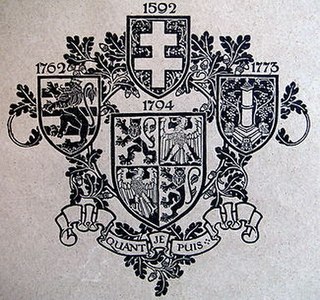
The Colleges of St Omer, Bruges and Liège were successive expatriate institutions for Roman Catholic higher education run by the Jesuits for English students.

St. George's Church, Sélestat, is a Gothic church in Sélestat, Bas-Rhin, Alsace, France. The church, of exceptional size and quality, is near the Humanist Library, which was founded in 1452 by Jean de Westhuss, priest at the church of St. George's. Originally dedicated to the Blessed Virgin Mary, the church has been named after Saint George since 1500 and is famous for its Christmas trees hung since 1521
Pierre Brûlart, Lord of Genlis and Crosne was a French statesman of the sixteenth century.

The Museum of Fine Arts is a fine arts museum in Reims, France.

The Église Saint-Paul-Saint-Louis is a church on rue Saint-Antoine in the Marais quarter of Paris. The present building was constructed from 1627 to '41 by the Jesuit architects Étienne Martellange and François Derand, on the orders of Louis XIII of France. It was the first church in Paris to break away entirely from the Gothic style and to use the new Baroque style of the Jesuits, and it had an important influence on Parisian religious architecture. It gives its name to Place Saint-Paul and its nearest Metro station, Saint-Paul. Next door to the church is the Lycée Charlemagne, also founded by the Jesuits.

Abbey of Saint-Pierre de la Couture was a Benedictine monastery in Le Mans. All that survives of it is the abbey church and some of the abbey buildings; the latter date to a rebuild between 1760 and 1775 and are now used to house the prefecture for Sarthe. Dating to the 11th century, the monastery was considered one of the most powerful in western France before the French Revolution.

Saint-Joseph of Reims is a private state-supported Catholic primary and secondary school, located in Reims, in the Marne department of the Grand Est region of France. The co-educational school was founded by the Society of Jesus in 1874. The school is located between Capuchin, Venice, 'Équerre, and Moulins streets in Reims. It enrolls 1,250 students from kindergarten through baccalaureate and houses 340 boarding students.

Notre Dame de Sainte Croix is a Catholic church located in the city of Le Mans, France. The church gives its name to the neighborhood itself. It was the first site of the Congregation of Holy Cross.
François Solier was a French Jesuit, head of the college of Limoges, preacher, translator of spiritual works into French and author of historical books.
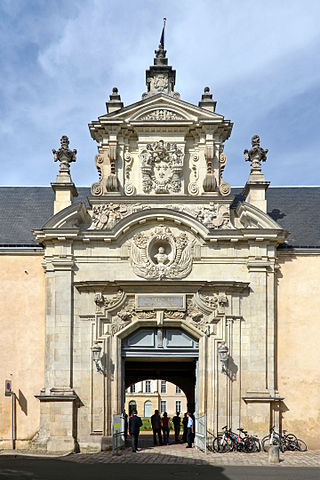
The Collège Henri-IV was a Jesuit educational institution located in La Flèche, in the department of Sarthe, France. Founded in 1603 by Henri IV, shortly after the king had recalled the Society of Jesus to France, the college prospered, quickly reaching over 1,000 students who followed the curriculum defined in the Ratio Studiorum. Some of them went on to become famous, such as the philosophers René Descartes and David Hume. The college was the first boarding school opened by the Jesuits.

The Colbert family is a surviving family of the French nobility, originally from Reims, Marne. Descended from merchants and bankers established in Reims and Troyes in the 16th century, the family formed several branches which successively acceded to the nobility during the 17th century. The Troyes line, a cadet branch which is the only branch surviving today, was the first to be ennobled in 1603 by the purchase of a position as Counselor Secretary to the King.






















